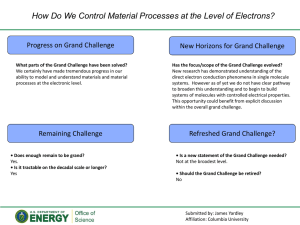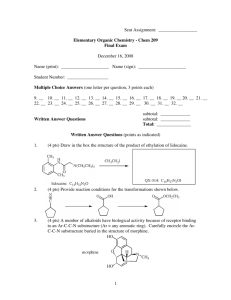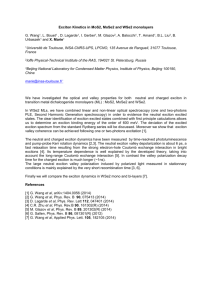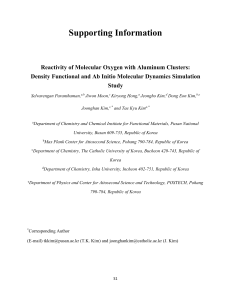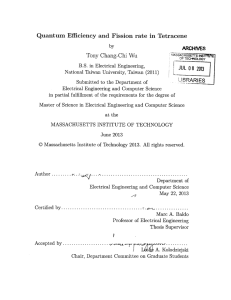Singlet fission efficiency in tetracene-based organic solar cells Please share
advertisement
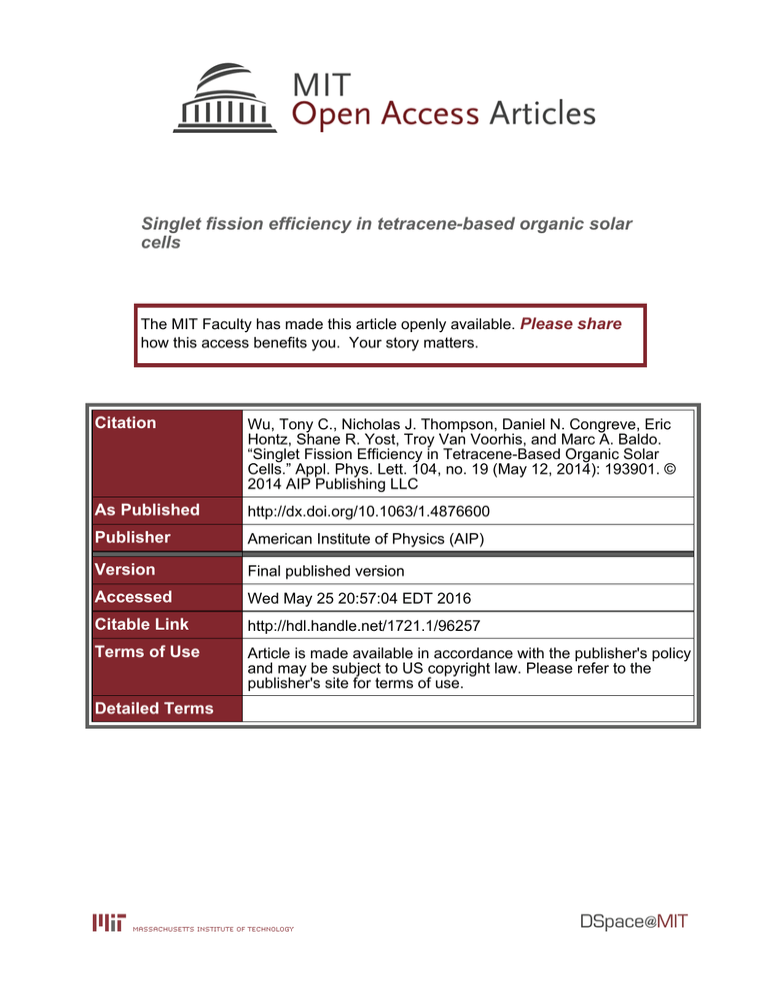
Singlet fission efficiency in tetracene-based organic solar cells The MIT Faculty has made this article openly available. Please share how this access benefits you. Your story matters. Citation Wu, Tony C., Nicholas J. Thompson, Daniel N. Congreve, Eric Hontz, Shane R. Yost, Troy Van Voorhis, and Marc A. Baldo. “Singlet Fission Efficiency in Tetracene-Based Organic Solar Cells.” Appl. Phys. Lett. 104, no. 19 (May 12, 2014): 193901. © 2014 AIP Publishing LLC As Published http://dx.doi.org/10.1063/1.4876600 Publisher American Institute of Physics (AIP) Version Final published version Accessed Wed May 25 20:57:04 EDT 2016 Citable Link http://hdl.handle.net/1721.1/96257 Terms of Use Article is made available in accordance with the publisher's policy and may be subject to US copyright law. Please refer to the publisher's site for terms of use. Detailed Terms Singlet fission efficiency in tetracene-based organic solar cells Tony C. Wu, Nicholas J. Thompson, Daniel N. Congreve, Eric Hontz, Shane R. Yost, Troy Van Voorhis, and Marc A. Baldo Citation: Applied Physics Letters 104, 193901 (2014); doi: 10.1063/1.4876600 View online: http://dx.doi.org/10.1063/1.4876600 View Table of Contents: http://scitation.aip.org/content/aip/journal/apl/104/19?ver=pdfcov Published by the AIP Publishing Articles you may be interested in Slow light enhanced singlet exciton fission solar cells with a 126% yield of electrons per photon Appl. Phys. Lett. 103, 263302 (2013); 10.1063/1.4858176 Electrical characterization of single-walled carbon nanotubes in organic solar cells by Kelvin probe force microscopy Appl. Phys. Lett. 96, 083302 (2010); 10.1063/1.3332489 Efficient organic solar cells based on a double p - i - n architecture using doped wide-gap transport layers Appl. Phys. Lett. 86, 244102 (2005); 10.1063/1.1935771 Efficient organic solar cells by penetration of conjugated polymers into perylene pigments J. Appl. Phys. 96, 6878 (2004); 10.1063/1.1804245 Efficient thin-film organic solar cells based on pentacene/ C 60 heterojunctions Appl. Phys. Lett. 85, 5427 (2004); 10.1063/1.1829777 This article is copyrighted as indicated in the article. Reuse of AIP content is subject to the terms at: http://scitation.aip.org/termsconditions. Downloaded to IP: 18.74.5.37 On: Sun, 22 Mar 2015 22:01:51 APPLIED PHYSICS LETTERS 104, 193901 (2014) Singlet fission efficiency in tetracene-based organic solar cells Tony C. Wu,a) Nicholas J. Thompson, Daniel N. Congreve, Eric Hontz, Shane R. Yost, Troy Van Voorhis, and Marc A. Baldob) Energy Frontier Research Center for Excitonics, Massachusetts Institute of Technology, Cambridge, Massachusetts 02139, USA (Received 11 March 2014; accepted 4 April 2014; published online 12 May 2014) Singlet exciton fission splits one singlet exciton into two triplet excitons. Using a joint analysis of photocurrent and fluorescence modulation under a magnetic field, we determine that the triplet yield within optimized tetracene organic photovoltaic devices is 153% 6 5% for a tetracene film thickness of 20 nm. The corresponding internal quantum efficiency is 127% 6 18%. These results are used to prove the effectiveness of a simplified triplet yield measurement that relies only on the magnetic field modulation of fluorescence. Despite its relatively slow rate of singlet fission, the measured triplet yields confirm that tetracene is presently the best candidate for use with silicon C 2014 AIP Publishing LLC. [http://dx.doi.org/10.1063/1.4876600] solar cells. V Exciton fission generates two excited states from one absorbed photon.1 When paired in a solar cell with suitable low energy gap materials, fission increases the power efficiency by enhancing photocurrent in the visible spectrum.2,3 Tetracene, for example, absorbs blue and green photons; exciton fission then generates two triplet excitons, each with energy 1.25 eV.4 This energy match to the bandgap of silicon (1.1 eV) provides special motivation for studying tetracene.2,5–9 It is the most efficient fission material yet identified that can partner with the predominant material of modern solar cells. Energy conservation during exciton fission requires that the initial exciton has approximately twice the energy of the product states. In tetracene, the fission process is thought to be slightly endothermic, resulting in a significant retardation of the rate.4 Nevertheless, the yield of triplet excitons is aided by spin conservation, which eliminates a thermalization loss pathway.10 The initial exciton is a singlet with total spin S ¼ 0 and it cannot rapidly decay into one lower-energy triplet exciton with total spin S ¼ 1. Only the generation of two triplets is allowed.11–14 Thus, singlet exciton fission in neat films of tetracene competes only with the relatively slow processes of singlet exciton fluorescence and nonradiative decay to the ground state. Indeed, multiple studies have shown or suggested a near unity efficiency for the fission process in neat films of tetracene.15,16 Singlet exciton fission in photovoltaic devices, however, is complicated by the presence of additional important loss pathways such as singlet exciton dissociation into charge; see Fig. 1(a).10,17 Consequently, it is typically insufficient to measure fission rates in neat thin films; practical applications require measurements of the triplet yield in devices. A lower limit is defined by the internal quantum efficiency (IQE)— the ratio of charges generated in the cell to photons absorbed. But determination of the IQE is especially challenging for tetracene devices, since its optical absorption overlaps with the usual acceptor material C60. Alternative approaches for a) tonyw@mit.edu baldo@mit.edu b) 0003-6951/2014/104(19)/193901/4/$30.00 measuring triplet yield based on the temperature dependence of fission in tetracene3 are also suspect given conflicting reports of the temperature dependence of the fission rate,15,18 and the magnetic field effect in tetracene.19 In this work, we couple measurements of the internal quantum efficiency in tetracene solar cells with analysis of the magnetic field dependence of photocurrent generation and tetracene fluorescence. When combined, these techniques address the weaknesses of previous measurements of triplet yield in tetracene.3 The approach is based on the dependence of singlet fission rates on applied magnetic fields. Spin conservation in the process jSi ! jTi þ jTi requires that the intermediate triplet-pair jTTi is formed with net spin of zero. In the absence of magnetic field splitting, there are three triplet-pair states with partial singlet character. The number of triplet pair states with partial singlet character increases to six under a weak applied magnetic field, and then decreases to two pairs under strong magnetic fields.20,21 Despite the varying redistribution of singlet character in the jTTi states, the forward rate of jSi ! jTTi summed over all jTTi states is unchanged by the redistribution of singlet character under the magnetic field.12,22 Only the reverse process FIG. 1. Dynamics of singlet fission and the magnetic field effect in tetracene. (a) A kinetic model including fluorescence as a possible singlet decay channel. (b) Fluorescence from a tetracene crystal (square) and thin film solar cells (triangle) as a function of magnetic field. The photocurrent from solar cell with a 30-nm-thick tetracene layer exhibits the opposite sign to the measured changes in fluorescence. 104, 193901-1 C 2014 AIP Publishing LLC V This article is copyrighted as indicated in the article. Reuse of AIP content is subject to the terms at: http://scitation.aip.org/termsconditions. Downloaded to IP: 18.74.5.37 On: Sun, 22 Mar 2015 22:01:51 193901-2 Wu et al. Appl. Phys. Lett. 104, 193901 (2014) is modulated because each possible jTTi ! jSi pathway from the manifold of jTTi states competes with additional processes such as diffusive separation or charge generation. Thus, the reverse process is maximized at high magnetic fields due to the substantial singlet character in the two triplet pair states formed by fission. We summarize the dynamics at high magnetic fields by combining the forward and reverse processes into an effective singlet exciton fission rate (kfis) that is reduced due to the enhancement of the reverse process.12 Fig. 1(b) is a plot of fluorescence from a tetracene single crystal as a function of magnetic field. It is compared to the fluorescence and photocurrent from tetracene photovoltaic cells under an applied magnetic field. The fluorescence trends are identical in single crystals and thin films incorporated in solar cells, but both are opposite to the photocurrent dependence. Fluorescence monitors the singlet exciton population, which increases as fission is slowed under a magnetic field. Conversely, the negative sign of the magnetic field effect on photocurrent demonstrates that a significant portion of charge formation originates in triplet excitons, which decrease under the magnetic field due to a slower fission rate. The magnetic field effects in Fig. 1(b) can provide a quantitative model of the yield of singlet exciton fission when they are combined with a kinetic model as described by Fig. 1(a).10 A photon is first absorbed by the fission material, creating a singlet exciton. The singlet exciton dynamics are modeled by three rates: the radiative decay rate, kR ; the rate of singlet exciton dissociation into charge, kS ; and the effective singlet exciton fission rate, kf is ðBÞ. It is notable that charge generation occurs at donor-acceptor interfaces, so kS can be tuned by adjusting the greatest exciton diffusion distance, d.10 Very thick tetracene layers have negligible singlet charge dissociation rates. Normalizing by the rate of fission under zero applied magnetic field, kf is ð0Þ ¼ kf0is , we define kf is ð BÞ ¼ vf is ðBÞ kf0is , kS ðdÞ ¼ vS ðd Þ kf0is , kR ¼ vR kf0is . The magnetic field-induced modulation, dI ðB; dÞ, of photocurrent, I, as a function of magnetic field, B, and greatest exciton diffusion distance, d, is ð IðB; d Þ I ð0; d ÞÞ Ið0; d Þ vf is ð BÞ 1 vS ðd Þ þ 2vR ¼ : vS ðdÞ þ vf is ð BÞ þ vR vS ðdÞ þ 2 dI ð B; d Þ ¼ Similarly, the magnetic field-induced modulation, dF ðB; dÞ, of fluorescence, F, is 1 vf is ðBÞ ðFðB; d Þ Fð0; d ÞÞ : dF ðB; d Þ ¼ ¼ Fð0; dÞ v ðdÞ þ v ð BÞ þ v S f is R For large magnetic fields B > 0:4T, the normalized fission rate vf is converges to a constant value vm f is . Under B > 0:4T, both dI ð B; d Þ and dF ðB; d Þ have a limiting case for d ! 1 when vS ! 0 vm f is 1 vR dI ð B > 0:4T; d ! 1Þ ¼ m ; vf is þ vR 1 vm f is dF ð B > 0:4T; d ! 1Þ ¼ m : vf is þ vR The photocurrent change also has an additional minimum value at a particular value of vS and d m vf is 1 dI ðB > 0:4T; dmax Þ ¼ : pffiffiffiffiffiffiffiffiffiffiffiffiffiffiffiffiffiffiffiffi qffiffiffiffiffiffiffiffiffiffiffiffiffiffiffiffiffiffiffiffiffi m ffi 2 vf is vR 2 ð1 v R Þ þ Any two of the three potential experimental measurements: dI ð B > 0:4T; d ! 1Þ, dF ðB>0:4T;d!1Þ, or dI ðB>0:4T; dmax Þ allows us to solve for vm f is and vR and then obtain vS ðd Þ by measuring dI ðB>0:4T;d Þ or dF ðB>0:4T;dÞ. But both photocurrent modulation measurements are complicated by additional photocurrent generation from C60 at overlapping wavelengths, forcing us to also estimate the IQE of tetracene and C60. Thus, obtaining the triplet yield from the magnetic field effect on photocurrent is hampered by the same problem that obstructs direct measurements of the IQE in tetracene. We can, however, correct a dI measurement at a tetracene thickness for which we expect the IQE to be most accurate, in this case dI ð B>0:4T;d!1Þ, and then rely on the dF measurement to predict the yield at varying thickness. Alternatively, we can find an approximate solution from the dF measurement alone. We explore both approaches below. The solar cell structures used to generate photocurrent and the energy levels of the constituent materials are shown in Fig. 2(a).10,14 For comparison, we build devices from tetracene and pentacene using C60 in both cases as an acceptor molecule. Fission is exothermic and significantly faster in pentacene, allowing us to study the impact of the fission rate on its yield in devices.10 To block exciton losses at the anode, an exciton blocking layer is placed beneath the singlet fission material.23 Based on the energy levels of the materials, we selected m-MTDATA for tetracene and P3HT for pentacene.10 Both blocking layers have triplet energies greater than the fission material and highest occupied molecular orbit (HOMO) levels appropriate for extracting holes from the fission materials. To accurately measure the IQE of tetracene, we first measure the solar cell’s external quantum efficiency (EQE) under different wavelengths of incident light. We also determine the optical n and k parameters of each of the materials.24 In Jadhav et al.,3 it was shown that characterizing the absorption of tetracene layer is difficult due to scattering. Here, we determine the n and k parameters from transmission-reflection spectra with additional aid from absorption spectra25 (measured in integrating sphere that includes scattered light). Using an optical transfer matrix approach,26 we then estimate each layer’s absorption spectra, fitting the overall EQE by separately adjusting the respective IQEs of tetracene and C60. The quality of the optical fit is assessed by comparing the measured photocurrent to the calculated absorption as a function of wavelength in Fig. 2(b). We find that the modeled photocurrent curve fits the This article is copyrighted as indicated in the article. Reuse of AIP content is subject to the terms at: http://scitation.aip.org/termsconditions. Downloaded to IP: 18.74.5.37 On: Sun, 22 Mar 2015 22:01:51 193901-3 Wu et al. FIG. 2. (a) The energy diagram for the photovoltaic cell and photodetector structures containing tetracene (Tc). The thickness of each layer is measured in nanometers and energy levels are in eV. m-MTDATA is introduced as a triplet exciton blocking layer to increase exciton dissociation at the donor/ acceptor interface. (b) Optical fitting of a photovoltaic cell with x ¼ 25 nm. The dashed blue and red curves are estimated tetracene and C60 contributions to the EQE. They are obtained by multiplying the absorption spectra of each layer by its IQE. The simulated photocurrent is a black dashed line and the measured EQE curve is a black solid line. experimental EQE data within a root mean squared error of 11%. Notably, there is a stronger k ¼ 520 nm shoulder in the modeled curve. Due to increasing photocurrent contributions from C60, the IQE of thin tetracene layers is extremely sensitive to small errors in n, k and uncorrected contributions from scattered light. Devices with thick layers of tetracene have lesser contributions from C60 to the photocurrent. Therefore, in Figs. 3(a) and 3(b), we use dI ðB > 0:4T; d ! 1Þ and dF ðB > 0:4T; d ! 1Þ to determine the normalized fission rate under a magnetic field, vm f is , and radiative loss rates, vR . For tetracene under strong magnetic fields of 0.4 T, we find vm f is ¼ 84:5% and vR ¼ 5:07%. From our measurement of fluorescence modulation under a magnetic field dF ðB > 0:4T; dÞ, we then calculate the normalized singlet loss rate vS ðd Þ as a function of tetracene thickness, which allows us to determine the triplet yield (2v0f is =ðvS þ v0f is þ vR Þ). Recall that these values are normalized by the zero field fission rate kf0is ¼ 10 ns1.6,11,16,27 FIG. 3. (a) and (b) The tetracene fluorescence change dF and photocurrent change dI under a magnetic field in both tetracene and pentacene. The tetracene fluorescence changes are measured in the same device used to determine the photocurrent change. (c) Tetracene and pentacene triplet exciton yields modeled from fluorescence and photocurrent changes, respectively. The red squares represent the triplet exciton yield approximated by the dF only-approach. Orange triangles represent the full calculation based on both dF and the photocurrent change dI as corrected by the IQE. (d) The IQEs of thin layers of pentacene and tetracene reflect the changes in triplet yield, and triplet diffusion losses in thick films. Pentacene data are from Ref. 10, and tetracene IQE data are from Ref. 14. Appl. Phys. Lett. 104, 193901 (2014) We also test a dF -only-approach to estimating vS and triplet yield. For most singlet fission materials, the radiative loss rates, vR , are significantly smaller than vf is . Under this assumption, we can simplify the magnetic field-induced modulation of fluorescence to dF ð B; d Þ ¼ ð1 vf is ðBÞÞ= ðvS ðd Þ þ vf is ð BÞÞ. Solving at dF ðB > 0:4T; d ! 1Þ we find ð Þ vm f is ¼ 85:2%. We then calculate vS d and the triplet exciton yield from dF ð B > 0:4T; d Þ. In Fig. 3(c), we show that this estimate of the triplet exciton yield agrees well with the full model. The dF -only-approach requires a quenching interface, but does not require a device structure engineered to extract photocurrent or measurement of the IQE, while still producing a good estimation of vm f is , vS , and triplet exciton yield. The accuracy of this approach could be further improved by including the ratio of fluorescence and fission rates as obtained from the photoluminescence transients in monomeric solutions and thin films; see Fig. 3 of Burdett et al.16 The triplet exciton yield of tetracene is plotted together with the triplet yield of pentacene in Fig. 3(c). The IQEs of solar cells are also plotted for comparison in Fig. 3(d). The data show similar trends as a function of fission material thickness, but the overall photovoltaic performance is significantly worse in tetracene with a peak IQE of 127% 6 18% as compared to 160% 6 10% in pentacene. Tetracene exhibits a relatively slow fission rate and hence it is less competitive with singlet exciton dissociation for thin tetracene layers. Consequently, the peak IQE in tetracene occurs for thicker layers where triplet diffusion losses are already significant. As demonstrated by the residual magnetic field modulation of photocurrent from thick tetracene layers, there are also losses due to fluorescence in tetracene, which is notably stronger than pentacene but still weaker than other losses. Subtracting from the maximum possible efficiency of 200%, we estimate that 20% of the potential photocurrent in our best device is lost due to singlet exciton dissociation (collecting one charge per singlet exciton instead of two), 8% to fluorescence, and the remaining 45% due to triplet exciton diffusion, yielding the final IQE value of 127% 6 18%. As additional verification for the determination of triplet yield, in Fig. 4, we compare our estimates of the singlet loss rate to measurements. As expected, the average rate of the extracted direct singlet exciton dissociation loss increases as the tetracene layer thickness decreases. In our thinnest photodetector, we determine kS ¼ 0:8kf0is , which is consistent with the measured rate of kS kf0is 8:3 ns1 for a tetracene-C60 blended thin film featured in Fig. 5(a) of Yost et al.14 FIG. 4. The normalized singlet dissociation rate, vS , as obtained from modeling the fluorescence change with a function of the greatest distance to a donor-acceptor interface. The vS of tetracene: C60 blend in Yost et al.14 was included as a comparison and test of our method. This article is copyrighted as indicated in the article. Reuse of AIP content is subject to the terms at: http://scitation.aip.org/termsconditions. Downloaded to IP: 18.74.5.37 On: Sun, 22 Mar 2015 22:01:51 193901-4 Wu et al. In conclusion, we find that the slow rate of singlet exciton fission in tetracene lowers its triplet yield within a 20 nm radius of a C60 interface. Pentacene exhibits faster exciton fission and higher yields at similar distances, highlighting the importance of designing exothermic rather than endothermic fission materials. Nevertheless, tetracene can yield internal quantum efficiencies that exceed 100%. In optimized organic solar cells, we find a peak triplet yield of 153% 6 5% with an IQE of 127% 6 18%. These results agree with prior work,3 although we find here that thicker layers of tetracene are required to optimally compete with singlet exciton dissociation. We have also demonstrated that the exciton yield in tetracene can be determined simply from the magnetic field modulation of fluorescence without measuring photocurrent or IQE. This work was supported as part of the Center for Excitonics, an Energy Frontier Research Center funded by the U.S. Department of Energy, Office of Science, Office of Basic Energy Sciences under Award No. DE-SC0001088 (MIT). D.N.C. was partially supported by the National Science Foundation Graduate Research Fellowship under Grant No. 1122374. 1 J. Lee, P. Jadhav, P. D. Reusswig, S. R. Yost, N. J. Thompson, D. N. Congreve, E. Hontz, T. Van Voorhis, and M. A. Baldo, Acc. Chem. Res. 46(6), 1300–1311 (2013). 2 D. L. Dexter, J. Chem. Phys. 21(5), 836–850 (1953). 3 P. J. Jadhav, A. Mohanty, J. Sussman, J. Lee, and M. A. Baldo, Nano Lett. 11(4), 1495–1498 (2011). 4 Y. Tomkiewicz, R. P. Groff, and P. Avakian, J. Chem. Phys. 54(10), 4504 (1971). 5 C.-W. Chu, Y. Shao, V. Shrotriya, and Y. Yang, Appl. Phys. Lett. 86(24), 243506 (2005). 6 J. J. Burdett, D. Gosztola, and C. J. Bardeen, J. Chem. Phys. 135(21), 214508 (2011). Appl. Phys. Lett. 104, 193901 (2014) 7 N. Geacintov, M. Pope, and F. Vogel, Phys. Rev. Lett. 22(12), 593–596 (1969). R. E. Merrifield, P. Avakian, and R. P. Groff, Chem. Phys. Lett. 3(3), 155–157 (1969). 9 Z. R. Hong, R. Lessmann, B. Maennig, Q. Huang, K. Harada, M. Riede, and K. Leo, J. Appl. Phys. 106(6), 064511 (2009). 10 D. N. Congreve, J. Lee, N. J. Thompson, E. Hontz, S. R. Yost, P. D. Reusswig, M. E. Bahlke, S. Reineke, T. Van Voorhis, and M. A. Baldo, Science 340(6130), 334–337 (2013). 11 M. Smith and J. Michl, Chem. Rev. 110(11), 6891–6936 (2010). 12 M. Pope and C. E. Swenberg, Electron Processes in Organic Crystals and Polymers (McGraw Hill, 1999). 13 W.-L. Chan, M. Ligges, A. Jailaubekov, L. Kaake, L. Miaja-Avila, and X.Y. Zhu, Science 334(6062), 1541–1545 (2011). 14 S. R. Yost, J. Lee, M. W. B. Wilson, T. Wu, D. P. McMahon, R. R. Parkhurst, N. J. Thompson, D. N. Congreve, A. Rao, K. Johnson, M. Y. Sfeir, M. Bawendi, T. M. Swager, R. H. Friend, M. A. Baldo, and T. Van Voorhis, “A transferable model for singlet fission kinetics,” Nature Chem. (published online). 15 V. K. Thorsmolle, R. D. Averitt, J. Demsar, D. L. Smith, S. Tretiak, R. L. Martin, X. Chi, B. K. Crone, A. P. Ramirez, and A. J. Taylor, Phys. Rev. Lett. 102(1), 017401 (2009). 16 J. J. Burdett, A. M. M€ uller, D. Gosztola, and C. J. Bardeen, J. Chem. Phys. 133(14), 144506 (2010). 17 J. Lee, P. Jadhav, and M. A. Baldo, Appl. Phys. Lett. 95(3), 033301 (2009). 18 R. P. Groff, P. Avakian, and R. E. Merrifield, Phys. Rev. B 1(2), 815–817 (1970). 19 M. W. B. Wilson, A. Rao, K. Johnson, S. Gelinas, R. di Pietro, J. Clark, and R. H. Friend, J. Am. Chem. Soc. 135(44), 16680–16688 (2013). 20 R. C. Johnson and R. E. Merrifield, Phys. Rev. B 1(2), 896–902 (1970). 21 V. Ern and R. E. Merrifield, Phys. Rev. Lett. 21(9), 609–611 (1968). 22 J. J. Burdett, G. B. Piland, and C. J. Bardeen, Chem. Phys. Lett. 585, 1–10 (2013). 23 P. D. Reusswig, D. N. Congreve, N. J. Thompson, and M. A. Baldo, Appl. Phys. Lett. 101(11), 113304 (2012). 24 H. A. H. Haus, Waves and Fields in Optoelectronics (Prentice Hall, 1983). 25 G. F. Burkhard, E. T. Hoke, and M. D. McGehee, Adv. Mater. 22, 3293–3297 (2010). 26 S. Jung, K.-Y. Kim, Y.-I. Lee, J.-H. Youn, H.-T. Moon, J. Jang, and J. Kim, Jpn. J. Appl. Phys. 50, 122301 (2011). 27 S. Arnold, R. R. Alfano, M. Pope, W. Yu, P. Ho, R. Selsby, J. Tharrats, and C. E. Swenberg, J. Chem. Phys. 64(12), 5104 (1976). 8 This article is copyrighted as indicated in the article. Reuse of AIP content is subject to the terms at: http://scitation.aip.org/termsconditions. Downloaded to IP: 18.74.5.37 On: Sun, 22 Mar 2015 22:01:51
